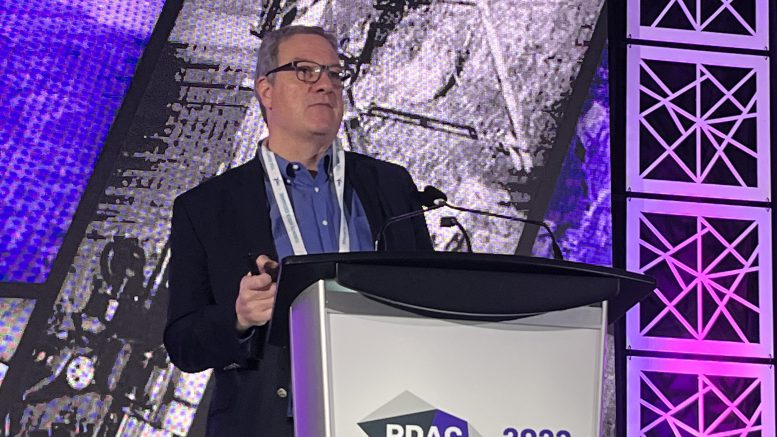The shift to green energy will demand the use of all metals, not just critical in a multi-trillion dollar industrial transition, said McKinsey’s Ken Hoffman at PDAC in Toronto on Sunday.
Delivering the first keynote speech of the four-day conference, Hoffman, who is head of the consultant’s battery raw materials team said that key critical metals like lithium and cobalt will be needed for the transition, but so will many other metals.
“It’s the entire spectrum, all sorts of metals are going to be needed,” he told the audience, as he gestured at a slide showing the contribution of metals towards the energy transition by 2030. “Lots of copper. There’s a lot – a lot – in infrastructure. We’re going to see a lot of aluminum. We’re going to see a lot of nickel.”

Indonesia will account for the highest value of mine supply of energy transition critical minerals by 2030, according to McKinsey & Co. Credit: Blair McBride
Hoffman pointed to the Inflation Reduction Act (IRA) passed by the U.S. Congress last August that earmarks US$369 billion in spending to incentivize clean energy technologies, as a major accelerator of the transition.
“[The IRA] could add US$1 trillion to the battery and sustainability value chain. One trillion dollars. It’s changed everything. It’s going to change metal flows. It’s going to change the pricing. It’s going to introduce premiums,” he said.
The Act’s requirement that electric vehicles contain a proportion of critical minerals and battery components sourced domestically or from countries with free trade deals with the U.S. will present opportunities for foreign miners, including Canadian ones. Some of those opportunities will come in the form of tax credits.
Hoffman said that while green energy producers as far away as Europe might seek to take advantage of those credits and “hard NIMBYism” in the U.S. hinders domestic mining and refining of critical minerals, American firms will still want to buy from legitimate sources.
“The energy transition will be everything, absolutely everything,” he said. “The industry itself is looking at something like a $15 to $20 trillion impact. And guess why? In the U.S. they don’t want to mine, but they want to buy from sources deemed localized, deemed acceptable to U.S. regulators. Canada, we love you. This is where it will come from,” Hoffman said, to laughter from the audience.
Presenting slides based on McKinsey research, Hoffman explained how by 2030 China will account for less of the global share of the critical minerals refining chain, with the Democratic Republic of the Congo (DRC), Australia and Indonesia accounting for a larger share of the supply of top minerals. China however, is still forecast to be a major player in mining of rare earths, tin and lithium.
In seven years, the value of Canada’s mined critical mineral supply will reach US$10.8 billion, higher than both China at US$9.2 billion and the U.S.’s US$7.8 billion, though far lower than Indonesia, at US$25.2 billion, which will top the global ranking, according to McKinsey.
Even though Hoffman said that “millions of jobs” will be lost in the transition away from the industrial model based on the combustion engine, that transition also presents huge opportunities to governments and the business sector if they can bring the right approach.
“It’s the perfect time to go to governments,” he said. “How can we work — particularly work with Indigenous communities — and how can we train people? It’s such a no-brainer. I think miners need to have their ducks lined up. What’s your strategy for getting the original equipment manufacturers interested? What is my ESG? Am I working with local communities? How am I going to have this refined… if you’re ready with the right project and the right boxes ticked, you’ll do well.”


Be the first to comment on "PDAC: Energy transition presents Canada with mining windfall, says McKinsey’s Hoffman"